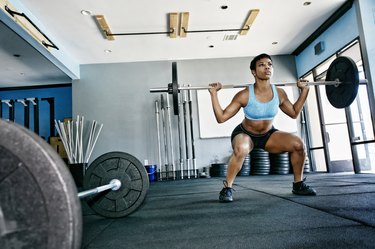
The squat is one of the most fundamental movement patterns. It's hard to imagine getting through a single day without doing at least a few squats. Sitting down on a chair, getting into your car and even sitting on the toilet are all movements involving squats.
In addition to being such a common movement for most people, squats are also an important and beneficial leg exercise used by bodybuilders, weightlifters and other athletes and exercisers looking to develop high levels of fitness, strength and performance.
Video of the Day
The squat is a compound exercise, meaning it targets several different joints — and hence, muscle groups — at once. Use the squat to train your lower body, as well as your core.
How to Do a Squat With Weights
- Duck under the bar and position yourself so that it rests high on the back of your upper shoulders. Make sure the bar rests on the meaty party of your shoulders, not on your neck, and grasp it on either side for stability.
- Stand up beneath the bar to take its weight on your legs. Step back into the squat rack/squat cage so that the bar will clear the racking pins, and set your feet shoulder-width apart. Adjust your position, if necessary, so that you're stable and balanced.
- Bend your knees as you move your hips back and down, as if you were sitting in a chair placed behind you. Keep your chest up, your back straight and your knees over your toes.
- Lower until your thighs are parallel with the ground (or as low as you can comfortably squat while maintaining good form).
- Press through your feet to reverse the motion and return to standing.
1. Core
Your core refers to all the muscles that support your spine, specifically your rectus abdominis, erector spinae, obliques and transversus abdominis. When you perform weighted squats, these muscles ensure your spine is held in the right position and that your lower back doesn't round.
Build up your core before doing heavy squats, as the support it provides helps prevent injury.
2. Hamstrings
Located at the back of your thighs and running from the base of your pelvis to just below the backs of your knees, your hamstrings are responsible for controlling hip extension when you squat.
There are three muscles that make up the hamstrings: biceps femoris, biceps semimembranosus and biceps semitendinosus. Working together, they act as a brake as you descend and then powerfully contract to extend your hip as you stand back up.
Tight hamstrings can result in a rounding of your lower back, so flexibility is important as well as strength.
3. Glutes
The rumors are true: Squats are an effective butt-building exercise. That's because your glutes (aka butt muscles) is a large and powerful muscle group that does a lot of work when you squat.
Located on the back of your hip and essentially your butt, your gluteus maximus, medius and mimimus work with your hamstrings and control your hip. Like your hamstrings, your glutes help control your descent and are involved in extending your hips as you push back up.
4. Quadriceps
Located on the front of your thigh and running from your hip to below your knee, your quadriceps are your primary knee extensor muscles.
Known as the quads for short, four muscles make up your quadriceps: rectus femoris, vastus intermedius, vastus lateralis and vastus medialis. They're the ones you're most likely to feel after a high-rep set of squats.
Related Reading
Additional Muscles
While there are a number of primary muscles involved in squatting, there are also several secondary muscles that help make this exercise possible. In fact, so many muscles are involved in a secondary capacity that squats are almost a full-body exercise.
The muscles on the inside and outside of your hips and thighs — your adductors and abductors — work to ensure your knees track over your feet and don't swing inward or outward. Your upper-body muscles also work to hold and support weights (ex. barbell or dumbbells) on the front or back of your shoulders, depending on whether you perform front or back squats.